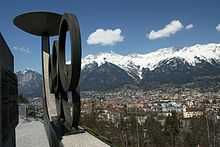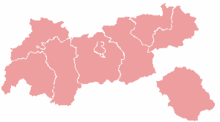Tyrol (state)
| Tyrol Tirol Tirolo | |||
|---|---|---|---|
| State of Austria | |||
| |||
 | |||
| Country |
| ||
| Capital | Innsbruck | ||
| Government | |||
| • Landeshauptmann | Günther Platter (ÖVP) | ||
| Area | |||
| • Total | 12,683.85 km2 (4,897.26 sq mi) | ||
| Population | |||
| • Total | 714,469 | ||
| • Density | 56.33/km2 (145.9/sq mi) | ||
| Time zone | CET (UTC+1) | ||
| • Summer (DST) | CEST (UTC+2) | ||
| ISO 3166 code | AT-7 | ||
| NUTS Region | AT3 | ||
| Votes in Bundesrat | 5 (of 62) | ||
| Website | www.tirol.gv.at | ||
Tyrol (/tɪˈroʊl, taɪ-, ˈtaɪroʊl/; German: ![]() Tirol (help·info), Italian: Tirolo) is a federal state (Bundesland) in western Austria. It comprises the Austrian part of the historic Princely County of Tyrol, corresponding with the present-day Euroregion Tyrol–South Tyrol–Trentino. The capital of Tyrol is Innsbruck.
Tirol (help·info), Italian: Tirolo) is a federal state (Bundesland) in western Austria. It comprises the Austrian part of the historic Princely County of Tyrol, corresponding with the present-day Euroregion Tyrol–South Tyrol–Trentino. The capital of Tyrol is Innsbruck.
Geography
The state is split into two parts – a larger called North Tyrol (Nordtirol), and the smaller East Tyrol (Osttirol) – by a 20-kilometre (12 mi) wide strip of the Alpine divide where the neighbouring Austrian state of Salzburg borders directly on the Italian province of South Tyrol. With a land area of 12,683.85 km2 (4,897.26 sq mi), it is the third largest state in Austria.
North Tyrol borders on the federal state of Salzburg in the east and on Vorarlberg in the west, in the north it adjoins the German state of Bavaria, and in the south Italian South Tyrol (Trentino-Alto Adige/Südtirol region) as well as the Swiss canton of Graubünden. East Tyrol also borders on the federal state of Carinthia in the east and on the Italian Province of Belluno (Veneto) in the south.
The state's territory is entirely located in the Eastern Alps at the important Brenner Pass. The highest mountain in the state is the Großglockner within the Hohe Tauern range at the border with Carinthia, and with an elevation of 3,797 m (12,457.35 ft) it is also the highest mountain of Austria.
Towns

The capital Innsbruck is known for its university, especially in medicine. Tyrol is popular for its famous ski resorts, which include Kitzbühel, Ischgl and St. Anton, but has no cities besides Innsbruck. To wit, the 14 largest towns in Tyrol are:
| Town | Inhabitants January 2011 | |
|---|---|---|
| 1. | Innsbruck | 120,147 |
| 2. | Kufstein | 17,388 |
| 3. | Telfs | 14,626 |
| 4. | Schwaz | 12,995 |
| 5. | Hall in Tirol | 12,695 |
| 6. | Wörgl | 12,645 |
| 7. | Lienz | 11,955 |
| 8. | Imst | 9,494 |
| 9. | Rum | 8,850 |
| 10. | St. Johann in Tirol | 8,766 |
| 11. | Kitzbühel | 8,207 |
| 12. | Landeck | 7,713 |
| 13. | Zirl | 7,641 |
| 14. | Wattens | 7,625 |
Administrative divisions

The state is divided into 9 districts (Bezirke), and the statutory city of Innsbruck. The districts and their administrative centres, from west to east and north to south, are:
Statutory city:
North Tyrol:
- Landeck District, (capital: Landeck)
- Reutte District, (Reutte)
- Imst District, (Imst)
- Innsbruck-Land, (Innsbruck)
- Innsbruck Stadt
- Schwaz District, (Schwaz)
- Kufstein District, (Kufstein)
- Kitzbühel District, (Kitzbühel)
East Tyrol:
History

In ancient times, the region was split between the Roman provinces of Raetia (left of the Inn River) and Noricum and from the mid-6th century was resettled by Germanic Bavarii tribes. In the Early Middle Ages it formed the southern part of the German stem duchy of Bavaria, until the Counts of Tyrol, former Vogt officials of the Trent and Brixen prince-bishops at Tirol Castle, achieved Imperial immediacy after the deposition of the Bavarian duke Henry the Proud in 1138 and their possessions formed a state of the Holy Roman Empire in its own right.
When the Counts of Tyrol became extinct in 1253, their estates were inherited by the Meinhardiner counts of Görz. In 1271 the Tyrolean possessions were divided between Count Meinhard II of Görz and his younger brother Albert I, who took the lands of East Tyrol around Lienz and attached it (as "outer county") to his comital possessions around Gorizia ("inner county"). The last Tyrolean countess of the Meinhardiner dynasty, Margaret bequeathed her assets to the Habsburg duke Rudolph IV of Austria in 1363. In 1420 the comital residence was relocated from Meran to Innsbruck. The Tyrolean lands were re-united, when the Habsburgs also inherited the estates of the extinct Counts of Görz in 1500.
In the course of the German mediatization in 1803, the prince-bishoprics of Trent and Brixen were secularized and merged into the County of Tyrol, which the next year became a constituent land of the Austrian Empire. But Tyrol was ceded to Kingdom of Bavaria in 1805. Laterly South Tyrol was ceded to Kingdom of Italy, was client state of First French Empire by Bavaria in 1810. After Napoleon's defeat whole Tyrol was returned to Austria in 1814. It was a Cisleithanian Kronland (royal territory) of Austria-Hungary from 1867. The County of Tyrol then extended beyond the boundaries of today's state, including in addition to North Tyrol and East Tyrol the Italian provinces of South Tyrol and Trentino (Welschtirol) as well as three municipalities, which today are part of the adjacent Province of Belluno. After World War I, these lands became part of the Kingdom of Italy according to the 1915 London Pact and the provisions of the Treaty of Saint Germain.
After World War II, Tyrol was governed by France until Austria regained independence in 1955.
See also
- Outline of Austria
- Euroregion Tyrol-South Tyrol-Trentino
External links
| Wikimedia Commons has media related to Tyrol (state). |
- Tirol Travel Guide
- Official Website of Provincial Government
- Sightseeing, History and Towns of Tyrol
| ||||||||||
Coordinates: 47°16′6.92″N 11°23′35.72″E / 47.2685889°N 11.3932556°E

